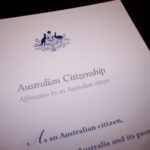 The Migration Act character test is well known and notorious. It is the subject of a large number of cases in both the AAT and in the Federal Court. It has been the subject of this blog on many occasions…. but not this month.
The Migration Act character test is well known and notorious. It is the subject of a large number of cases in both the AAT and in the Federal Court. It has been the subject of this blog on many occasions…. but not this month.
Many permanent residents (who survive the character test) will one day want to apply for Australian citizenship by conferral. They must meet the residence requirement of having lived in Australia on a valid visa for 4 years and with one of those years being on a permanent visa. There is also a citizenship character test.
Definition of the citizenship character test
The citizenship character test is contained in section 21(2)(h) of the Australian Citizenship Act. The applicant has to be “of good character” at the time that the application is decided. For the vast majority of people this won’t present a problem. However, there can be issues when there is conduct which is below the threshold for s501 or which occurred a long time ago.
Good character for the purpose of citizenship is not defined. However, there is a common law meaning. The Full Federal Court in Irving v Minister for Immigration, Local Government and Ethnic Affairs (1996) 68 FCR 422 at 431-432 contains the following: Unless the terms of the Act and Regulations require some other meaning be applied, the words “good character” should be taken to be used in their ordinary sense, namely, a reference to the enduring moral qualities of a person, and not to the good standing, fame or repute of that person in the community. The former is an objective assessment apt to be proved as a fact whilst the latter is a review [of] subjective public opinion… .
Citizenship policy
The Australian Citizenship Policy Statement (Policy) and the Citizenship Procedural Instruction 15 (CPI 15) says the phrase ’enduring moral qualities’ encompasses (a) characteristics which have endured over a long period of time; (b) distinguishing right from wrong; and (c) behaving in an ethical manner, conforming to the rules and values of Australian society. Relevantly, CPI 15 provides that a person who is of good character would generally be expected to exhibit certain characteristics. These include to abide by the law in Australia, not practice deception or fraud in dealings with the Australian Government, or other organisations and to not cause harm to others through their conduct.
A more recent summary of the requirements is set out in BOY19 [2019] FCA 574:
The following principles can be distilled from the authorities about the meaning of the expression “good character” in s 21(2)(h) of the Act. First, it refers to the enduring moral qualities of a person and not to the good standing, fame or repute of that person in the community, although the latter may provide evidence of the former. The expression is not concerned with the physical or intellectual attributes or abilities of a person. Second, the expression does not have a fixed and precise content. ….. Third, and as a corollary of the second point, the expression requires a judgment as to whether any proved deficiencies in the moral qualities of a person are sufficient to deny the person citizenship.
Citizenship – a privilege
Finally, I note the words of Deputy President Breen in Fenn and Minister for Immigration and Multicultural Affairs [2000] AATA 931 at [8]: The grant of Australian citizenship is a privilege not bestowed lightly. It is given to those who uphold the values of the Australian community and who are willing to make a positive contribution to the country they want to call home…The refusal to grant citizenship is not a second form of punishment, which is the domain of the Criminal Courts. It is simply the right of the Australian community to decide whom they wish to have included as fellow citizens, which is a function of State. The refusal does not deprive Mr Fenn of any rights he currently holds, nor does it prevent him applying for citizenship again in a few years’ time when he can demonstrate a longer period of positive contribution to the Australian community.
Creative commons acknowledgment for the photograph.